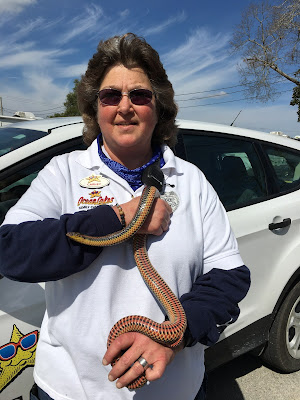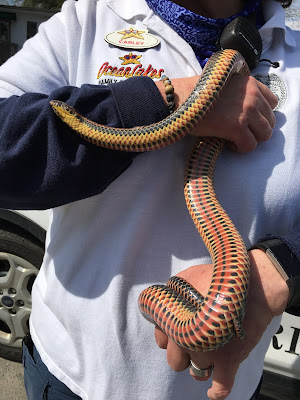A Colorful Ocean Lakes Rescue Mission
Slither on over here, Ocean Lakes, and listen to this awesome rescue mission performed by our Security Teammate, Carley!
Carley came across a Rainbow Snake behind the Recreation Center. The snake had injuries that needed medical treatment, so the Snake Chaser was contacted and his partner, Jamie, has taken the snake. He will make sure it gets the needed medical attention and care.
Before We Get Started | It is probably a good thing Carley was the Teammate that found the snake – I would have been terrified. We know snakes can be scary, but when you take the time to learn about them, you will find that not all snakes are bad snakes.
So, that is what we are talking about today – Let’s learn a thing or two about the Rainbow Snake!
We reached out to our Master Naturalist at The Nature Center, Brandy Cloos, for more information on the Rainbow Snake |
Rainbow Snake, or Farancia erytrogramma, has its name for a reason – Take a look at its beautiful colors!
You Gon’ Learn Today | Brandy provided us with a few fun facts about the Rainbow Snake. Follow along and learn about this colorful creature:
- Adult snakes are typically 3 - 5.5 ft. long, and females will grow larger than males.
- This is one of the most colorful snakes in the Southeast.
- The dorsal (top) side is usually a blue-black color with 3 longitudinal (head to tail) red stripes .
- The ventral (underbelly) side is mostly red or pink with 2 or 3 rows of black spots.
- Can be found throughout the Coastal Plain from Virginia to Mississippi and Louisiana near rivers, large creeks, cypress swamps, lakes, canals, large ditches, and fresh and brackish marshes.
- They are highly aquatic snakes that are very secretive and elusive as they are mostly nocturnal.
- The Rainbow Snake is classified as "Least Concern", which is like any typical animal.
Map It Out | Below is the range map and classification from IUCN. The map uses the term extant range, which is the opposite of extinct. This just means that they are living.
Time To Eat | Juvenile Rainbow Snakes have a diet consisting mostly of amphibians. Adult Rainbow Snakes feed largely on American Eels (Anguilla rostrata), and use their tail spine to hold onto the slimy prey. Many of our avid guest fisherman may recall that our freshwater lakes are home to many American Eels, especially when fishing at night, which means our lakes are an ideal habitat for this eel eating snake.
No Need To Worry | Rainbow Snakes are not venomous and pose no threat to humans but should be left alone if encountered in the wild. The snake found in Ocean Lakes was injured and needed to be taken to a wildlife rehabber immediately. These snakes hardly ever bite when captured and are very docile toward humans.
Caution | Although not all snakes are bad snakes, we advise against picking up any snakes in the wild!
Ending On A Funny Note | What do you call a funny snake? Hisssssssterical!
*Knee slapper*
Until Next Time | For further information, questions, or concerns, reach out to The Nature Center at (843) 828-4837! Or feel free to email Brandy at bcloos@oceanlakes.com.







Comments
Post a Comment